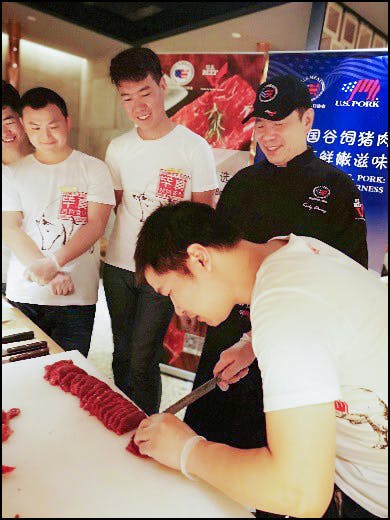U.S. Beef, Pork Focus of Trainings for Large Chain Restaurants in China
Working to put U.S. red meat at the center of Korean barbecue and hot pot menus in China, USMEF partnered with China National Cereals, Oils and Foodstuffs Corporation (COFCO) to conduct three foodservice training sessions for a pair of chain restaurants that have hundreds of locations across the country. Funded by the Beef Checkoff Program and the National Pork Board, the trainings in Shanghai were attended by employees of Little Sheep and Pankoo restaurants.

USMEF demonstrates how to cut U.S. beef to employees of the Little Sheep hot pot restaurant chain in China
“Hot pot is currently the most popular cuisine in China, and there are more than 350,000 hot pot restaurants operating right now,” said Ming Liang, USMEF marketing director in China.
Liang cited national statistics that show hot pot restaurants account for 17 percent of total foodservice sector consumption in China. In 2017, hot pot dishes accounted for nearly one-fourth of the catering industry’s production. Likewise, Korean barbecue has become a popular cuisine, especially with consumers age 20 to 40.
Engaging the two chains and sharing information about U.S. beef and pork was a strategic move, Liang explained.

Employees of the Pankoo Korean barbecue chain restaurant in China participated in foodservice training conducted by USMEF
“Both Little Sheep, a hot pot chain, and Pankoo, a Korean barbecue chain, have hundreds of restaurants all over the country,” he said, adding that the two companies are supplied by COFCO, China's largest food processor, manufacturer and trader. “Both chains intend to upgrade their products to meet the huge demand for high-quality meat, and we have made great efforts to convince them that U.S. red meat is the ideal product for these dishes.”
During the training sessions, USMEF provided an overview of the U.S. red meat industry, explained the U.S. beef grading system, demonstrated meat cutting and plating procedures and offered various application ideas for cuts. Tasting sessions also allowed participants to sample U.S. beef and pork. USMEF included an introduction to the “meat box” concept and explained proper storage and defrosting of red meat.

Ming Liang, USMEF marketing director in China, presents the U.S. meat box concept to employees of the Pankoo restaurant chain
Liang said the meat box concept was developed to help distributors, importers, foodservice operators and retailers utilize secondary cuts of beef and pork. It is especially valuable to the Korean barbecue and hot pot sectors of the foodservice industry.
“For example, market demand for U.S. short ribs and short plates exceeds the current level of China-eligible supply,” he explained. “USMEF identifies similar muscle cuts, breaks down the cost structure of each cut, then assists customers in finding a cut that meets their needs. It is an effort to further push secondary cuts such as clod hearts, sirloin caps and outside flat. With the meat box concept, we may replace the short ribs with chuck short ribs, or short plates with knuckles slices. Or we may replace the whole menu with chuck short ribs, knuckles slices and chuck tender at much lower costs.”

Employees of the Pankoo Korean barbecue chain restaurant in China participated in foodservice training conducted by USMEF
USMEF butchers and chefs performed cutting demonstrations using U.S. beef outside round flat, knuckle, chuck roll, tenderloin, top sirloin cap, shoulder clod and mock tender, along with U.S. pork CT butt and boneless pork loin.
In the weeks following the training sessions, Liang followed up with both restaurant chains and learned that each had increased interests in U.S. beef and pork.
“Little sheep started using Pork CT butt after the training, and the average consumption at their restaurants is around 500 kilograms per month and they plan to start using U.S. beef soon,” Liang said.
“Meanwhile, Pankoo has purchased about 200 metric tons of U.S. beef since the market reopened last year. U.S. beef top blade muscle, short ribs and bottom sirloin butt are on their menus. They’re also planning to use beef shoulder clod and pork CT butt to expand and improve their menus.”
